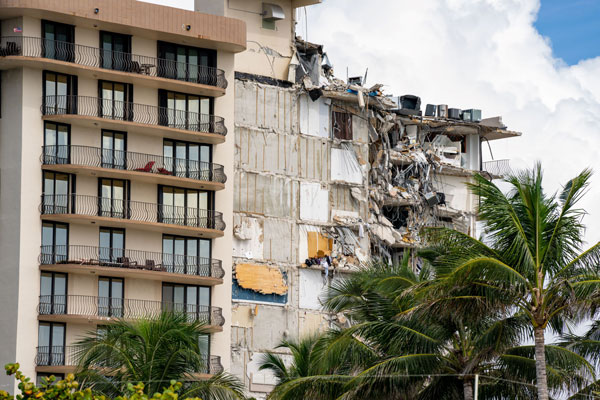What Causes Concrete Buildings to Collapse and How Attorneys Can Help Survivors
By Space Coast Daily // June 29, 2021

The tragic partial collapse of the Champlain Towers building in Surfside, Florida, has brought the world’s attention to the issue of unsafe concrete buildings in the United States and around the world. The catastrophic loss of life and property in the Champlain Towers underscores the need for proper planning, construction, and maintenance of these buildings.
Surfside building collapse lawyer SteinLaw explores why concrete buildings may collapse and shares how law firms like theirs can help victims and their families with their losses.
Why Concrete Buildings Collapse
After the failure of the Surfside tower, many people want to know how and why such a large building could fail with almost no warning. Concrete buildings are subject to many stresses from the environment and poor construction and inspection techniques.
To understand why concrete buildings may be subject to collapse, we must first understand the building process.
How Concrete Structures Are Built
A concrete structure is erected with metal forms holding the concrete in place during the curing process. Large trucks pour the concrete into the forms. Concrete buildings are built one floor at a time, with each floor being allowed to cure before the next floor is built.
Reinforced concrete is a building material used in nearly all concrete structures today. Beginning in the mid-1800s, reinforced concrete could bring more stability to these buildings and reduce their brittleness.
Steel pieces called rebar are introduced to the concrete forms, and the concrete is poured around them. The rebar from the walls and floors is tied together structurally.
Several examples of structural forces could lead to the failure of a concrete building like the Champlain Towers. While the investigation into the tragic collapse of this building has only just begun, it is possible that engineers examining the building’s remains may discover that one or more of these factors are at fault.
Miami condo collapse lawyer SteinLaw explains some of the stressors that may cause concrete buildings to fail.
Water Damage
Concrete buildings are sometimes imperiled by water damage. Waterproofing on the lower areas of the structural slab is a must since groundwater or nearby seawater can come up under the floor and corrode the concrete.
Flat structural slabs can also cause problems with water. When the slab is flat, water is not able to run off. Having a tilted slab means that the lower floor of the building stays dry and avoids undermining the foundation.
The rebar can also be affected by water damage. Saltwater is especially dangerous for rebar since it introduces corrosive minerals and compounds. Water can cause structural failure in this case as well.
Beach sand was used to make concrete in prior decades, and this could introduce another avenue of corrosion into the concrete.
Earth Movements
Instability of the land under the building could also lead to collapses. Many buildings in Surfside and the Miami Beach area were built on barrier islands with limestone underneath.
Limestone is a potentially unstable rock that is easy to break. It is unknown whether the Champlain Towers building had pillars extending underneath the limestone and into the bedrock. A Miami building collapse lawyer will be able to help you while authorities are determining the exact cause.
Concrete Damage
Concrete damage has caused many building collapses over the years. While concrete degrades over time, it can last up to 100 years under optimal conditions. During its useful life, concrete may require repairs and maintenance.
Concrete damage is a potential culprit of the Surfside tower collapse, and regulators and engineers examine it.
Lack of Oversight and Inspections
Many scientists and engineers believe that Florida’s existing laws for inspecting concrete buildings are not sufficient. Concrete buildings in Florida are inspected only once every 40 years. Tragically, the tower was 40 years old when it failed. A Champlain tower building collapse attorney may help survivors determine whether a lack of inspection is at fault in the failure of the building.
Examples of Concrete Building Collapses and Their Causes
Following are examples of concrete building collapses that have happened over the past several decades, together with reasons for their failure.
Hard Rock Hotel, New Orleans
During construction, the Hard Rock Hotel in New Orleans experienced major structural failure on October 12, 2019. The partial collapse killed three workers and injured many more.
Weaknesses in the structural steel and poor construction practices are targeted as causes for the building’s failure.
Skyline Plaza Apartment Building, Virginia
This building collapsed during construction in March 1973. Fifteen workers were killed, and 40 more were injured. Inspectors determined that punching shear failure of the 23rd floor caused the collapse. Experts also decided that the concrete had not yet cured enough to be structurally ready.
How Attorneys Can Help
Surfside condo collapse lawyer SteinLaw can help survivors and their families recover damages from the responsible parties. While no one yet knows exactly why the Surfside condominiums collapsed, scientists and engineers will discover the answer and place the blame.
While many concrete buildings are built to last, others are vulnerable to collapse. Considering these causes, firms like SteinLaw can assist survivors and family members in receiving the compensation they are due after such a catastrophic event. Contact a Miami building collapse lawyer for help in dealing with this tragedy.











